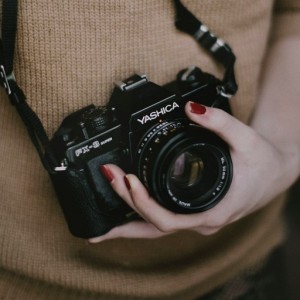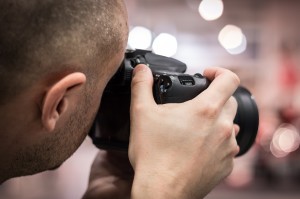What is a Typical DSLR Camera and How does it Work?
A DSLR full abbreviation is digital single lens reflex camera. There is a single lens through which the light, from the image to be captured, enters the camera. By using a single lens, you get a real time image, as seen on the view finder. For those interested in photography, a DSLR is a great way to expand your horizons.
The first DSLR camera was introduced by Nikon in 1999. Over the last decade, major improvements have been made in DSLR technology and several companies like Sony, Kodak, Olympus and Pentax entered the DSLR market.
Today, DSLR cameras are popular not just with photographers, but also with the common consumers.
A DSLR is a digital camera that uses mirrors to direct light and the image we see rebounds up to the viewfinder. A DSLR is cabable of switching lenses.
Here are the key components of a DSLR camera
1. Interchangeable Lenses
This is one of the key features which contributes to the popularity of DSLR cameras. You can change the lens and select the one which suits your photographic requirement. It is recommended that you start small and buy better, sharper and more expensive lenses as you go along.
Most of the time, photographers opt for lenses made by the same companies which make cameras. These are called first party lenses. For instance, companies like Nikon, Canon and Sony manufacture both cameras and lenses.
But, a point to be remembered is that the manufacturer of the lens and camera must be the same. A Nikon lens cannot be attached to a Sony Camera.
Then there are third party lenses. They are manufactured by companies like Sigma, Tamron and Tokina. With the correct lens mount, these lenses can be attached to cameras from different manufacturers.
First party lenses offer better quality, whereas third party lenses can be chosen if you are under a budget.
2. CMOS Sensors
The main feature of a DSLR camera, CMOS (Complementary Metal Oxide Semiconductor) is a type of an image sensor. It helps record the image you capture. For better understanding, it can be thought of as the film which was used in older cameras.
Another type of sensor used in DSLR cameras is the CCD (Charged Couple Device) sensor. But most DSLRs use CMOS, as it is cheaper and uses less power, thereby allowing cameras to become smaller and more powerful. The only drawback is that CMOS sensors lead to a lot of image noise. CCD sensors create high quality and low noise images. But improvements are being made to CMOS Sensors very rapidly.
Canon has been using CMOS sensors in their high end cameras for a long time.
3. Mode Dial
The Mode Dial is a dial on your DSLR camera, which helps you change camera or scene settings. It gives you access to the various shooting modes.
The dial includes – automatic mode, M which is the manual mode, P which stands for Program Mode, S or shutter priority mode and A or AV which is the aperture priority mode.
- In Auto mode, all the settings including exposure, aperture, light and focus are determined by your DSLR camera. It is often represented by a green box on the dial.
- The Manual Mode allows you to have complete control over all the camera functions. It may seem tough at first, but once you get the hang of it, the manual mode is easy to master. Manual Mode lets you set the aperture and shutter speed independently.
- The shutter speed, represented in seconds, is the time that the sensor is exposed to the light, from the scene to be captured. In simpler terms, it is the amount of time that the shutter is open. Slow shutter speed can be used in low light conditions or to introduce a blur in the picture. Fast shutter speed can be used to capture a quick moment like a falling drop of a liquid.
- Aperture, measured by F-stops, controls the amount of light that enters the camera. The higher the F-number, the more of the image will be in focus. For example, if you want to capture a photo of an animal, while blurring the background, a lower aperture is suitable. A landscape photo needs a higher aperture so as to keep the entire area in focus.
- P or the Program mode chooses the aperture and shutter speed for you, but other important aspects like Flash, White balance and Exposure are in your control. It can be thought of as a semi-automatic mode.
- A or AV, the aperture priority mode, allows you to choose the Aperture value, and automatically choose the right shutter speed to match it. This helps in getting the best exposure for the image. The Aperture priority mode is preferred by most photographers.
4. Live View
As the name suggests, Live view is all about letting you see a preview of the image captured, on the LCD screen of the DSLR. Using the live view, you can get the picture composition right every time. A grid can be placed over the image, thereby ensuring that the picture is straight and accurate.
A big advantage of the live view is that it is easy to see and capture images when it is difficult for the photographer to get his eye to the viewfinder. The only disadvantage is that the Live View drains the battery faster.
5. Image Stabilization
This feature is especially for those with shaky hands. Additionally, it helps in clicking pictures in dim light, without flash. Also, it is great for clicking photos when the camera is moving around a lot. However, you should remember that image stabilization is not for clicking fast moving objects.
Image stabilization is of two types-
- Built into the camera. This is also known as body stabilization. Brands like Pentax, Olympus and Sony offer these cameras
- Built into the lens. Nikon and Canon offer this.
How to use a DSLR camera to take a picture
Here is the process how DSLR creates an image
- You decide the picture angle and press the shutter button
- The mirror in the camera flips upwards and reflects the light even more further in order to block any more light entering the view finder
- The aperture narrows down and the shutter opens. All the light that entered the camera hits the sensor. This is called exposure
- As soon as the exposure is over, the shutter goes back to normal and the mirror flips down
- After its done, you will be able to see the captured image on the LCD screen
It is because of these features that the popularity of DSLR cameras is rising rapidly, especially among the youth. The major drawback is the weight of the camera and equipment. Efforts are being made to improve image quality, while reducing the bulkiness of the imaging equipment.

